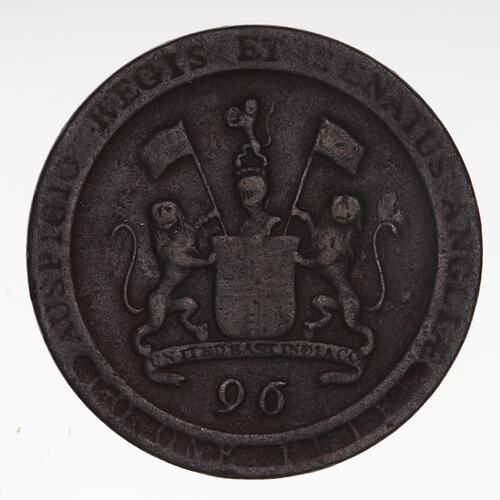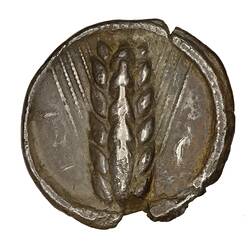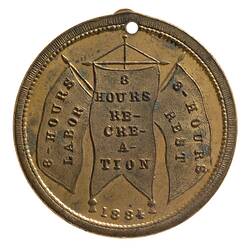Summary
1/2 Dub or 1/96 Rupee, Issued by, Northern Circars, Madras Presidency, India, 1794
Minted by Soho Mint, Birmingham
Obverse Description
Within a broad rim, the company arms, a quartered shield (oval crowned Royal shield in the first quarter of the shield (worn) else plain); crest of a helm with lion holding the Imperial Crown; lion supporters, each holding a banner charged with a cross; below incuse on ribbon, UNITED EAST INDIA CO.; below ribbon, 96; on rim below, TO ONE RUPEE; around above, incuse on rim, the motto, AUSPICIO REGIS ET SENATUS ANGLICAE
Reverse Description
Within a broad rim, the company balemark; around above, incuse on rim, UNITED EAST INDIA COMPANY; below, incuse on rim, 1794
Edge Description
incuse, ENGLISH UNITED EAST INDIA COMPANY
Significance
The territory known as the Northern Circars was ceded to the EIC by the Nizam of Hyderabad on 12 November 1766. Coinage consisted of gold pagodas, silver rupees and copper dubs. The copper dub was rated at 48 to the rupee (as stated on this coin) but was not accepted by the government in payment with the result that it market value fluctuated, often 10% in a single day. To end this situation a large orde of copper coins was made with the Soho MInt, Birmingham, England in 1794. There, Matthew Boulton was experimenting withstriking legends into a raised rim on coins and tokens, to increase their circulation life by resisting wear. The EIC elected a design which combined both raised and incuse lettering and ordered coins of 1/48th and 1/96th rupee. Shipment began on 8 November 1794, with 4,616,129 1/48th and 9,102,868 96th pieces sent by 4 March 1795. The coins proved successful and a second large order was placed in 1796 (the coins dated 1797, the year they would be issued).
More Information
-
Collection Names
-
Collecting Areas
-
Acquisition Information
Transfer from National Gallery of Victoria (NGV), George McArthur, 15 Mar 1976
-
Date Issued
1794 AD
-
Issued By
-
Mint
-
Denomination
-
Series
-
Material
Copper
-
Axis
06
-
Classification
-
Category
-
Discipline
-
Type of item
-
Dimensions
24.5 mm (Outside Diameter), 6.78 g (Weight)
-
Shape
Round
-
References
Pridmore 319 KM#392
[Book] Pridmore, Fred. 1975. The Coins of the British Commonwealth of Nations, Part 4, India. 1., 50 & 88-89 Pages
[Book] Bruce, Colin R. 2007. Standard Catalogue of World Coins 1701 - 1800., 826 Pages
[Book] Doty, Richard. 1998. The Soho Mint and the Industrialization of Money., 311-312 Pages
-
Keywords
British Commonwealth Coins, British Commonwealth and Empire Coins






